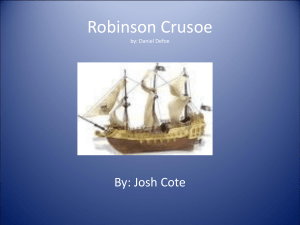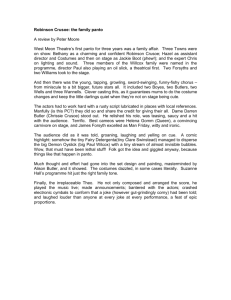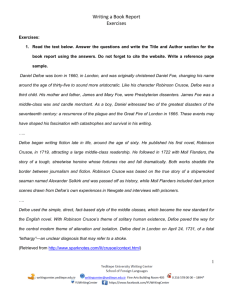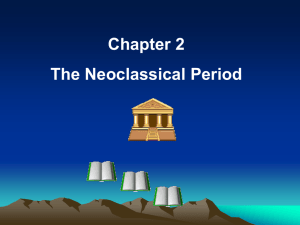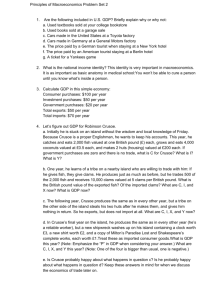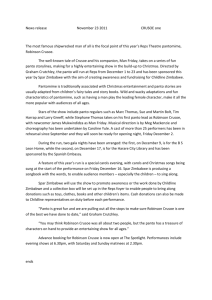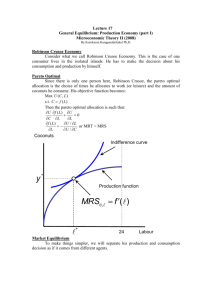Robinson Crusoe
advertisement
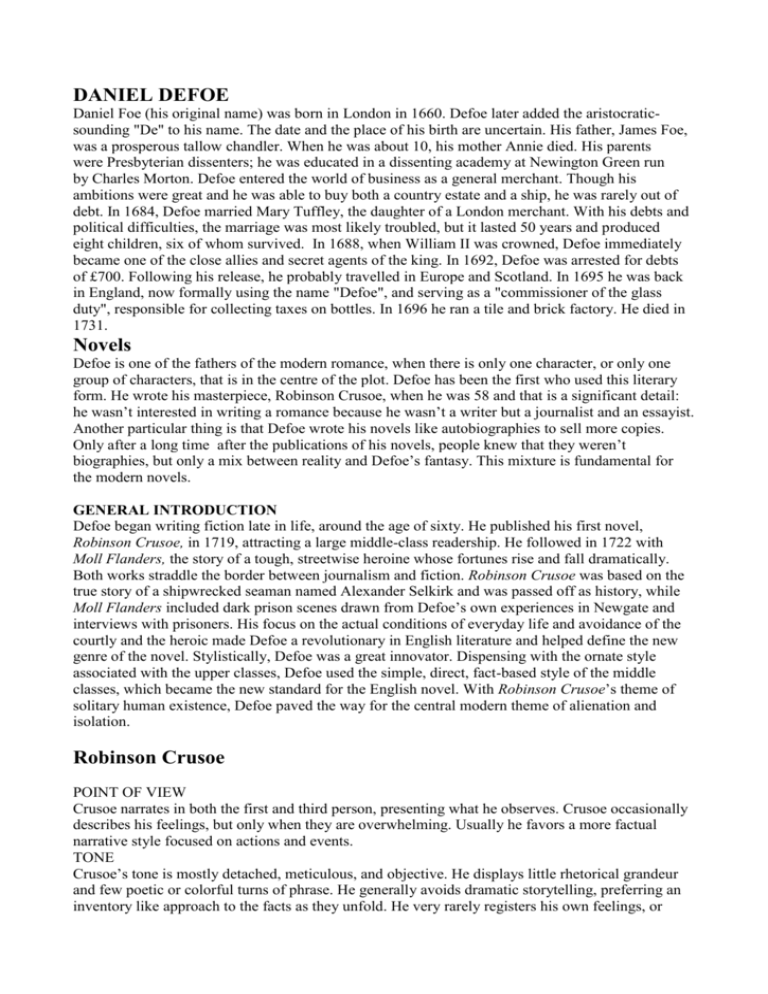
DANIEL DEFOE Daniel Foe (his original name) was born in London in 1660. Defoe later added the aristocraticsounding "De" to his name. The date and the place of his birth are uncertain. His father, James Foe, was a prosperous tallow chandler. When he was about 10, his mother Annie died. His parents were Presbyterian dissenters; he was educated in a dissenting academy at Newington Green run by Charles Morton. Defoe entered the world of business as a general merchant. Though his ambitions were great and he was able to buy both a country estate and a ship, he was rarely out of debt. In 1684, Defoe married Mary Tuffley, the daughter of a London merchant. With his debts and political difficulties, the marriage was most likely troubled, but it lasted 50 years and produced eight children, six of whom survived. In 1688, when William II was crowned, Defoe immediately became one of the close allies and secret agents of the king. In 1692, Defoe was arrested for debts of £700. Following his release, he probably travelled in Europe and Scotland. In 1695 he was back in England, now formally using the name "Defoe", and serving as a "commissioner of the glass duty", responsible for collecting taxes on bottles. In 1696 he ran a tile and brick factory. He died in 1731. Novels Defoe is one of the fathers of the modern romance, when there is only one character, or only one group of characters, that is in the centre of the plot. Defoe has been the first who used this literary form. He wrote his masterpiece, Robinson Crusoe, when he was 58 and that is a significant detail: he wasn’t interested in writing a romance because he wasn’t a writer but a journalist and an essayist. Another particular thing is that Defoe wrote his novels like autobiographies to sell more copies. Only after a long time after the publications of his novels, people knew that they weren’t biographies, but only a mix between reality and Defoe’s fantasy. This mixture is fundamental for the modern novels. GENERAL INTRODUCTION Defoe began writing fiction late in life, around the age of sixty. He published his first novel, Robinson Crusoe, in 1719, attracting a large middle-class readership. He followed in 1722 with Moll Flanders, the story of a tough, streetwise heroine whose fortunes rise and fall dramatically. Both works straddle the border between journalism and fiction. Robinson Crusoe was based on the true story of a shipwrecked seaman named Alexander Selkirk and was passed off as history, while Moll Flanders included dark prison scenes drawn from Defoe’s own experiences in Newgate and interviews with prisoners. His focus on the actual conditions of everyday life and avoidance of the courtly and the heroic made Defoe a revolutionary in English literature and helped define the new genre of the novel. Stylistically, Defoe was a great innovator. Dispensing with the ornate style associated with the upper classes, Defoe used the simple, direct, fact-based style of the middle classes, which became the new standard for the English novel. With Robinson Crusoe’s theme of solitary human existence, Defoe paved the way for the central modern theme of alienation and isolation. Robinson Crusoe POINT OF VIEW Crusoe narrates in both the first and third person, presenting what he observes. Crusoe occasionally describes his feelings, but only when they are overwhelming. Usually he favors a more factual narrative style focused on actions and events. TONE Crusoe’s tone is mostly detached, meticulous, and objective. He displays little rhetorical grandeur and few poetic or colorful turns of phrase. He generally avoids dramatic storytelling, preferring an inventory like approach to the facts as they unfold. He very rarely registers his own feelings, or those of other characters, and only does so when those feelings affect a situation directly, such as when he describes the mutineers as tired and confused, indicating that their fatigue allows them to be defeated. THE MAIN CHARACTER Robinson Crusoe - The novel’s protagonist and narrator. Crusoe begins the novel as a young middle-class man in York in search of a career. He father recommends the law, but Crusoe yearns for a life at sea, and his subsequent rebellion and decision to become a merchant is the starting point for the whole adventure that follows. His vague but recurring feelings of guilt over his disobedience color the first part of the first half of the story and show us how deep Crusoe’s religious fear is. Crusoe is steady and plodding in everything he does, and his perseverance ensures his survival through storms, enslavement, and a twenty-eight-year isolation on a desert island. PLOT Robinson Crusoe was born in York in 1632. He always wants to travel by sea, like a merchant, although his father would like to see him as a doctor of law. Finally at the age of 18 he sets sails from Queen's dock, in Hull, in a tumultuous journey, that lasts less than a year. Despite the difficulties, he travels again by ship the next year. This time Salé Pirates deport him as a moor. After two years he manages to escape with a young boy called Xuri from the pirates. He meets a Portuguese ship where he "sells" Xuri to buy his freedom. The ship goes to Brazil where Robinson buys a plantation. After a little time, Robinson sails again to bring there slaves from Africa: a shipwreck doesn't let him do it. He is the only survivor after the storm. He begins to colonize the island, he manages to survive for more then 20 years using first the tools from the wreck, then he becomes independent. One day he discovers a footprint on his island: he isn't alone as he believed before. One night he looks for the tribe, that he discovers to be one of cannibals and when he finds it, he kills some of them with his guns, while the others, that are frightened, run away; after that he frees a prisoner of that tribe, who becomes his slave. Robinson teaches Friday, that is the name of the new slave, the English language, the Christian religion, converting him, and other things that seems useful to the colonizer. After a few years, Robinson and Friday go to kill the other members of the cannibal tribe. They manage to kill almost all of them and they save Friday's father and a Spaniard, who informs him about other Spaniards shipwrecked on the mainland. Robinson meets the Spaniards and he makes arrangements with them. After that, an English ship with mutineering sailors arrives. Robinson strikes a deal with the captain of the ship: Robinson with him and a few sailors that aren't so angry with the captain are going to sail back to England. After 28 years Robinson finally goes back home. In 1687 after a little period where he stays at home, he sails again to Lisbon, to reclaim the profits of his estate in Brazil. Finally he does a final journey to the Island, that has become a flourishing colony. SYMBOLS AND ANALYSIS The Footprint Crusoe’s shocking discovery of a single footprint on the sand in Chapter XVIII is one of the most famous moments in the novel, and it symbolizes our hero’s conflicted feelings about human companionship. Crusoe has earlier confessed how much he misses companionship, yet the evidence of a man on his island sends him into a panic. Immediately he interprets the footprint negatively, as the print of the devil or of an aggressor. He never for a moment entertains hope that it could belong to an angel or another European who could rescue or befriend him. This instinctively negative and fearful attitude toward others makes us consider the possibility that Crusoe may not want to return to human society after all, and that the isolation he is experiencing may actually be his ideal state The Ambivalence of Mastery Crusoe’s success in mastering his situation, overcoming his obstacles, and controlling his environment shows the condition of mastery in a positive light, at least at the beginning of the novel. Crusoe lands in an inhospitable environment and makes it his home. His taming and domestication of wild goats and parrots with Crusoe as their master illustrates his newfound control. Moreover, Crusoe’s mastery over nature makes him a master of his fate and of himself. Early in the novel, he frequently blames himself for disobeying his father’s advice or blames the destiny that drove him to sea. But in the later part of the novel, Crusoe stops viewing himself as a passive victim and strikes a new note of self-determination. In building a home for himself on the island, he finds that he is master of his life—he suffers a hard fate and still finds prosperity. But this theme of mastery becomes more complex and less positive after Friday’s arrival, when the idea of mastery comes to apply more to unfair relationships between humans. In Chapter XXIII, Crusoe teaches Friday the word “[m]aster” even before teaching him “yes” and “no,” and indeed he lets him “know that was to be [Crusoe’s] name.” Crusoe never entertains the idea of considering Friday a friend or equal—for some reason, superiority comes instinctively to him. We further question Crusoe’s right to be called “[m]aster” when he later refers to himself as “king” over the natives and Europeans, who are his “subjects.” In short, while Crusoe seems praiseworthy in mastering his fate, the praiseworthiness of his mastery over his fellow humans is more doubtful. Defoe explores the link between the two in his depiction of the colonial mind. Ordeals at Sea Crusoe’s encounters with water in the novel are often associated not simply with hardship, but with a kind of symbolic ordeal, or test of character. First, the storm off the coast of Yarmouth frightens Crusoe’s friend away from a life at sea, but does not deter Crusoe. Then, in his first trading voyage, he proves himself a capable merchant, and in his second one, he shows he is able to survive enslavement. His escape from his Moorish master and his successful encounter with the Africans both occur at sea. Most significantly, Crusoe survives his shipwreck after a lengthy immersion in water. But the sea remains a source of danger and fear even later, when the cannibals arrive in canoes. The Spanish shipwreck reminds Crusoe of the destructive power of water and of his own good fortune in surviving it. All the life-testing water imagery in the novel has subtle associations with the rite of baptism, by which Christians prove their faith and enter a new life saved by Christ Colony Robinson Crusoe is also the British colonialism. "The whole Anglo-Saxon spirit is in Crusoe: the manly independence, the unconscious cruelty, the persistence, the slow yet efficient intelligence, the sexual apathy, the calculating taciturnity." From novelist James Joyce. In a sense Crusoe attempts to replicate his society on the island. This is achieved through the use of European technology, agriculture and even a rudimentary political hierarchy. Several times in the novel Crusoe refers to himself as the 'king' of the island, whilst the captain describes him as the 'governor' to the mutineers. At the very end of the novel the island is explicitly referred to as a 'colony'. The idealized master-servant relationship Defoe depicts between Crusoe and Friday can also be seen in terms of cultural imperialism. The relation with Friday can be an example of savage imperialism. MOLL FLANDERS The Fortunes and Misfortunes of the Famous Moll Flanders (commonly known simply as Moll Flanders) is a novel written by Daniel Defoe in 1721, after his work as a journalist and pamphleteer. It is hard to write a plot of Moll Flanders because this book is like an autobiography and it is full of events and stories. We can divide it into 4 parts. The first part goes from the birth of Moll Flanders (who was born in Newgate prison by a woman who was a thief and a prostitute) at her first marriage. At this stage of the story, the protagonist is an unlucky orphan first, then a little girl who wants to become 'a lady'; she becomes a beautiful girl who lives in a respectable family and who is seduced by the first-born of the same family. At the end she marries the younger brother. The second part shows us a young lady Moll Flanders who, after the death of her first husband, alternates short periods of widowhood with a long series of unfortunate relationships and marriages. In the third part, Moll becomes a clever thief who will succeed to accumulate almost a fortune. In the fourth and last part, finally, after being detained in Newgate, Moll will be deported to Virginia where she finds one of her husbands and one of her children (the one born from the marriage with the ‘younger brother’). There is someone who believes that the story is a narrative representation of capitalism because there are a lot of allusions to cash, contracts and other topics related to money. Everything, including people, has a monetary value. This may give the reader the feeling of the calculating personality of Moll. Capitalism, however, did not quickly become a familiar concept so it is better to believe that Defoe, who was himself a prisoner in Newgate just wanted to represent the social life of the Eighteenth century.
